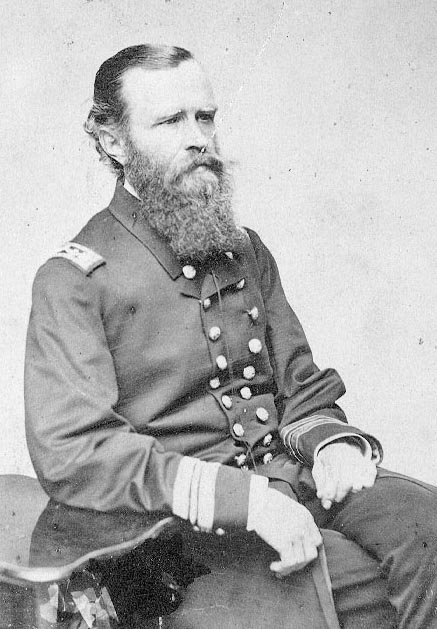Rear Admiral John Lorimer Worden, U.S.N.
Official Navy biography

John Lorimer Worden was born on 12 March 1818 in Westchester County, N.Y., and was appointed midshipman in the Navy on 10 January 1834. He served his first three years in the sloop-of-war Erie on the Brazilian Station. Following that, he was briefly assigned to the sloop Cyane before reporting to the Naval School at Philadelphia for seven months of instruction. He returned to sea in July 1840 for two years with the Pacific Squadron. Between 1844 and 1846, Worden was stationed at the Naval Observatory in Washington, D.C.
During the Mexican-American War, he cruised the west coast, primarily in the store ship Southampton, but in other ships as well. In 1850, he returned to the Naval Observatory for another two-year tour of duty. The ensuing nine years were filled with sea duty that took Worden on several cruises in the Caribbean and Mediterranean.
Brought to Washington early in 1861, he received orders in April to carry secret dispatches — regarding the reinforcement of Fort Pickens — south to the warships at Pensacola, Florida. During the return journey north, Worden was arrested near Montgomery, Alabama, and was held prisoner until exchanged about seven months later.
Though still ill as a result of his imprisonment, Cmdr. Worden accepted orders to command the new ironclad Monitor on 16 January 1862. He reported to her building site at Greenpoint, Long Island, and supervised her completion. He placed the new warship in commission at the New York Navy Yard on 25 February and two days later sailed for Hampton Roads, Virginia. However, steering failure forced the ironclad back to New York for repairs.
On 6 March 1862, she headed south again, this time under tow by the steam tug Seth Low. On the afternoon of 8 March 1862, Worden’s command approached Cape Henry, Virginia; meanwhile, inside Hampton Roads the Confederacy’s own ironclad, C.S.S. Virginia, wreaked havoc with the Union Navy’s wooden blockading fleet.
During that engagement, the Southern warship sank the sloop Cumberland and severely damaged Congress and Minnesota before retiring behind Sewell’s Point. Arriving on the scene too late to participate in the engagement, Worden and his command set about assisting the grounded Minnesota.
At daybreak on 9 March 1862, Virginia emerged once more from behind Sewell’s Point to complete her reduction of the Federal fleet at Hampton Roads. As the Confederate ironclad approached Minnesota, Worden maneuvered Monitor from the grounded ship’s shadow to engage Virginia in the battle that revolutionized naval warfare. For four hours, the two iron-plated ships slugged it out as they maneuvered in the narrow channel of Hampton Roads, pouring shot and shell at one another to almost no visible effect.
Three hours into the slug fest, Worden received facial wounds when a Confederate shell exploded just outside the pilot house. He relinquished command to his first officer, Lt. Samuel Dana Green. About an hour later, Monitor withdrew from the battle temporarily and, upon her return to the scene, found that Virginia, too, had withdrawn. The first battle between armored steam-driven ships had ended in a draw.
After the battle, Worden moved ashore to convalesce from his wounds. During that recuperative period, he received the accolade of a grateful nation and the official thanks of Congress. Late in 1862, he took command of the ironclad monitor Montauk and placed her in commission at New York on 14 December 1862. Later in the month, Worden took his new ship south to join the South Atlantic Blockading Squadron off Port Royal, South Carolina.

On 27 January 1863, he led his ship in the bombardment of Fort McAllister, Georgia. A month later, newly promoted Capt. Worden took his ship into the Ogeechee River in Georgia, found the Confederate privateer Rattlesnake (formerly C.S.S. Nashville), and destroyed it with five well-placed shots. His last action came on 7 April 1863, when Montauk participated in an attack on Charleston, South Carolina.
Not long after the Charleston attack, Capt. Worden received orders to shore duty in conjunction with the construction of ironclads at New York. That assignment lasted until the late 1860s. In 1869, he began a five-year tour as superintendent of the Naval Academy during which he was promoted to rear admiral.
During the late 1870s, he commanded the European Squadron, visiting ports in northern Europe and patrolling the eastern Mediterranean during the Russo-Turkish War of 1877-78. He returned ashore and concluded his naval career as a member of the Examining Board and as president of the Retiring Board. When he retired on 23 December 1886, Congress voted him full sea pay in his grade for life.
Rear Admiral Worden resided in Washington, D.C., until his death from pneumonia on 19 October 1897. After funeral services at Washington’s St. John’s Episcopal Church, he was buried at Pawling, New York.